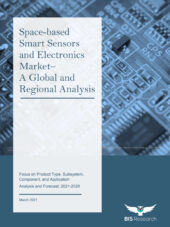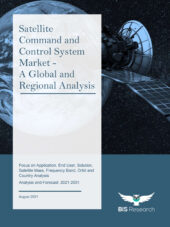Description
Satellite Communication (Satcom) Market: Segmented: by solution (Products and Services): by platform (Portable, Land Mobile, Land Fixed, Airborne, and Maritime), And Region – Global Analysis Of Market Size, Share & Trends For 2019–2020 And Forecasts To 2031
[ 176 + Pages Research Report ] Impact of COVID-19 on Satellite Communication (Satcom) Market to surpass USD 84 billion by 2031 from USD 21.43 billion in 2021 at a CAGR of 13.8% in the coming years, i.e., 2021-31.
Product Overview
SATCOM refers to the method of sending data from one location to another via a satellite orbiting the Earth. Telecommunication is the most prevalent application for satellites. SATCOM is used for mobile applications such as communication with ships, aircraft, vehicles, hand-held terminals, and transmission of TV and radio. Satellite communication is the transmission of signals via a satellite in the form of a beam of modulated waves between the transmitter and reception antenna. These signals are amplified and delivered back to the earth’s surface reception antenna. In remote locations, satellite communication (SATCOM) is also critical for improving communication technology infrastructure.
Market Highlights
Global Satellite Communication (Satcom) market is expected to project a notable CAGR of 20.1% in 2031.
The increased use of electronically guided phased antennas for platforms such as commercial vehicles, military vehicles, trains, and boats has resulted from increased demand for communication on-the-move (OTM) solutions (ESPA). Even when platforms such as military vehicles, trains, or boats are in motion, these antennas can track and maintain satellite links. In this phased array for OTM, hybrid beam steering is used, both electrically for elevation and mechanically for azimuth. Because the steering of an antenna terminal is so important in gaining a satellite link, ESPA is utilized to prevent mechanical motion.
Global Satellite Communication (Satcom): Segments
Products segment to grow with the highest CAGR during 2021-31
Global Satellite Communication (Satcom) Market is fragmented by solution into Products and Services. From 2021 to 2031, the market for products is predicted to lead the SATCOM equipment market in terms of solutions. This is owing to rising demand for phased-array antenna systems in airborne and maritime platforms, high-speed data transfer in aircraft, the necessity for high-bandwidth data in difficult and isolated locations, and weather-proof antenna enclosures. NASA’s Glenn Research Center awarded Comtech Telecommunications Corp. a contract for a Ka-/S-band antenna system and radome to be constructed at its new Aerospace Communications Facility in Cleveland, OH, to support high-bandwidth space and aeronautics communications research in February 2021.
An airborne segment to grow with the highest CAGR during 2021-31
Global Satellite Communication (Satcom) market is segmented by the platform into Portable, Land Mobile, Land Fixed, Airborne, and Maritime. According to platform, the airborne SATCOM segment is expected to lead the SATCOM equipment market from 2021 to 2026, and it is expected to grow even faster due to the growing demand for high-definition intelligence, surveillance, and reconnaissance (ISR) videos, as well as the growing number of connected commercial aircraft, rising adoption of UAVs, and growing number of private aviation companies around the world. The French Air Force improved their airborne satellite communication capability in December 2019 by implementing new Thales technologies. Thales was awarded a contract by the French Defense Agency to design and build the next-generation Syracuse 4 satellite communication system. The French military forces will be able to improve the SATCOM system in the Charles De Gaulle Aircraft Carrier and the Rafale combat aircraft owing to this contract.
Market Dynamics
Drivers
The increased use of electronically guided phased antennas
The increased use of electronically guided phased antennas for platforms such as commercial vehicles, military vehicles, trains, and boats has resulted from increased demand for communication on-the-move (OTM) solutions (ESPA). Even when platforms such as military vehicles, trains, or boats are in motion, these antennas can track and maintain satellite links. In this phased array for OTM, hybrid beam steering is used, both electrically for elevation and mechanically for azimuth. Because the steering of an antenna terminal is so important in gaining a satellite link, ESPA is utilized to prevent mechanical motion.
Penetration of small and portable SATCOM
One of the smallest 2-way satellite communication devices is a portable SATCOM terminal, often known as a satellite communicator or hotspot. The device collects location data using an inbuilt GPS chip. When the SEND is activated, this data is sent through commercial satellites to a commercial monitoring agency, which then passes it on to the relevant reacting agency. Participants in activities such as hiking, mountain biking, climbing, sailing, and flying are typical users/purchasers of these gadgets. It’s also beneficial to individuals who operate in remote locations (loggers, foresters, geologists, fisheries, and wildlife staff). Sending pre-programmed messages and breadcrumb tracking using Google Earth are two other options. Some contemporary devices support two-way satellite communication.
Restraint
High initial and maintenance cost
One of the biggest issues impeding the market’s growth is the high cost of developing and maintaining earth station infrastructure. The majority of the essential components are custom-fabricated or obtained from commercial off-the-shelf (COTS) manufacturers, both of which are costly. Furthermore, the design, development, and construction of antennas and their components necessitate a significant amount of time and effort on the part of trained experts. The required level of ability is a considerable barrier to access. The value chains of these systems also demand significant investments in R&D, production, system integration, and assembly.
Global Satellite Communication (Satcom): Key Players
SES S.A.
Company Overview, Business Strategy, Key Product Offerings, Financial Performance, Key Performance Indicators, Risk Analysis, Recent Development, Regional Presence, SWOT Analysis
Viasat, Inc.
Intelsat
Telesat
EchoStar Corporation
L3 Technologies, Inc.
Thuraya Telecommunications Company
SKY Perfect JSAT Group
GILAT SATELLITE NETWORKS
Cobham Limited
Other Prominent Players
Global Satellite Communication (Satcom): Regions
Global Satellite Communication (Satcom) market is segmented based on regional analysis into five major regions: North America, Latin America, Europe, Asia Pacific, and the Middle East and Africa. North America accounted for XX percent of the market in 2021, and the region is expected to grow at a CAGR of XX percent over the next decade. From 2021 to 2031, North America is predicted to lead the SATCOM equipment market. In the North American region, the United States has a lucrative market for SATCOM equipment. To improve the quality and effectiveness of satellite communication, the US government is boosting its investments in the field of SATCOM. Key factors expected to drive the SATCOM equipment market in North America include increased investment in SATCOM equipment to enhance armed forces defense and surveillance capabilities, modernization of existing communication in military platforms, critical infrastructure, and law enforcement agencies are increasingly using SATCOM equipment.
Impact of Covid-19 on Satellite Communication (Satcom) Market
The COVID-19 pandemic has wreaked havoc on countries’ economies all around the world. SATCOM equipment manufacturing, including systems, subsystems, and components, has also been affected. Despite the fact that SATCOM equipment is vital for a successful satellite mission, supply chain interruptions have put a stop to their production for the time being. The level of COVID-19 exposure, the level at which manufacturing operations are functioning, and import-export rules, among other things, all have a role in resuming manufacturing activity. While businesses may continue to accept orders, delivery timetables may not be set in stone.
Global Satellite Communication (Satcom) is further segmented by region into:
North America Market Size, Share, Trends, Opportunities, Y-o-Y Growth, CAGR – the United States and Canada
Latin America Market Size, Share, Trends, Opportunities, Y-o-Y Growth, CAGR – Mexico, Argentina, Brazil and Rest of Latin America
Europe Market Size, Share, Trends, Opportunities, Y-o-Y Growth, CAGR – United Kingdom, France, Germany, Italy, Spain, Belgium, Hungary, Luxembourg, Netherlands, Poland, NORDIC, Russia, Turkey and Rest of Europe
Asia Pacific Market Size, Share, Trends, Opportunities, Y-o-Y Growth, CAGR – India, China, South Korea, Japan, Malaysia, Indonesia, New Zealand, Australia and Rest of APAC
Middle East and Africa Market Size, Share, Trends, Opportunities, Y-o-Y Growth, CAGR – North Africa, Israel, GCC, South Africa and Rest of MENA
Global Satellite Communication (Satcom) report also contains analysis on:
Satellite Communication (Satcom) Segments:
By solution
Products
Services
By platform
Portable
Land Mobile
Land Fixed
Airborne
Maritime
Satellite Communication (Satcom) Dynamics
Satellite Communication (Satcom) Size
Supply & Demand
Current Trends/Issues/Challenges
Competition & Companies Involved in the Market
Value Chain of the Market
Market Drivers and Restraints
Satellite Communication (Satcom) Market Report Scope and Segmentation
Report Attribute Details
Market size value in 2021 USD 21.43 billion
Revenue forecast in 2031 USD 84 billion
Growth Rate CAGR of 20.1% from 2021 to 2031
Base year for estimation 2021
Quantitative units Revenue in USD million and CAGR from 2021 to 2030
Report coverage Revenue forecast, company ranking, competitive landscape, growth factors, and trends
Segments covered solution, product and Region
Regional scope North America, Europe, Asia Pacific, Latin America, Middle East & Africa (MEA)
Key companies profiled SES S.A.; Viasat, Inc.; Intelsat; Telesat; EchoStar Corporation; L3 Technologies, Inc.; Thuraya Telecommunications Company; SKY Perfect JSAT Group; GILAT SATELLITE NETWORKS; Cobham Limited , and Other Prominent Players.
Related Reports: Research Report on Automobile Air-Conditioner Industry in China, 2018-2022






Reviews
There are no reviews yet.